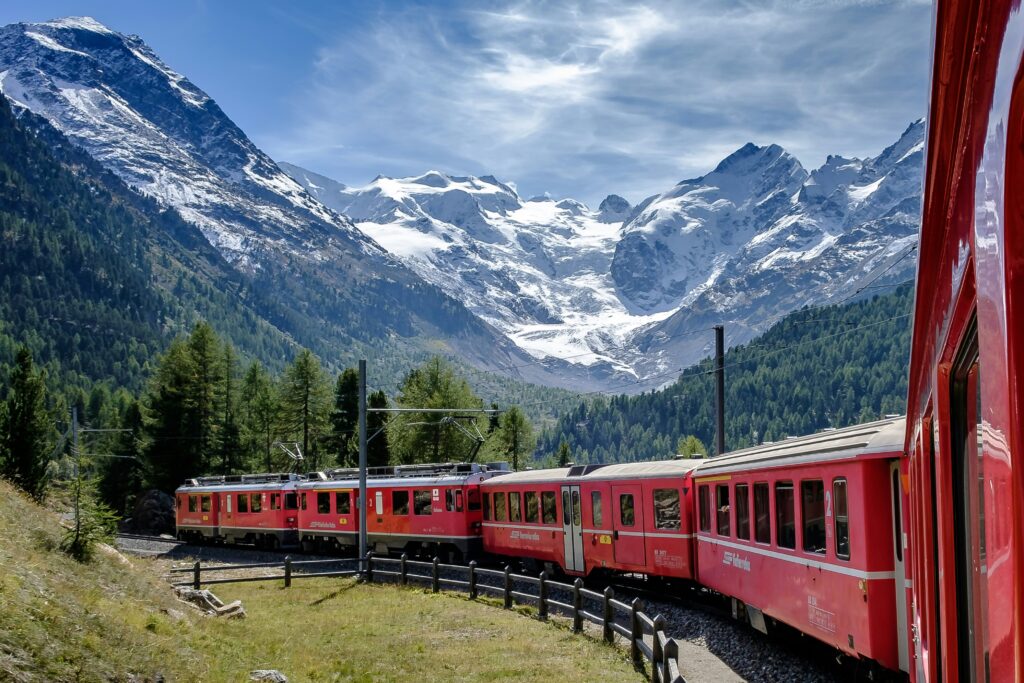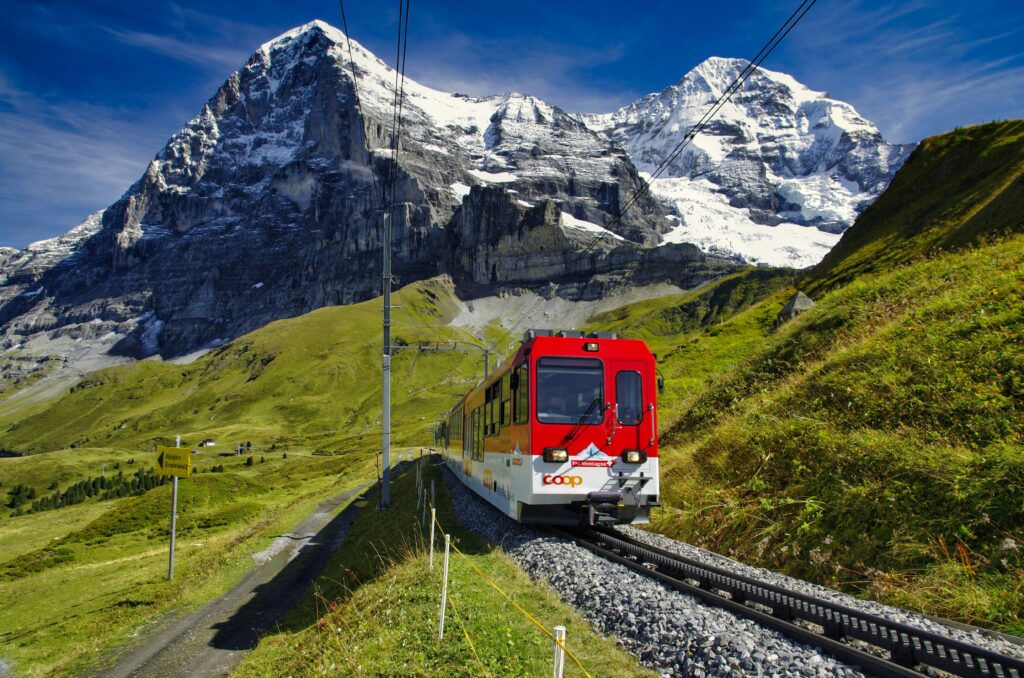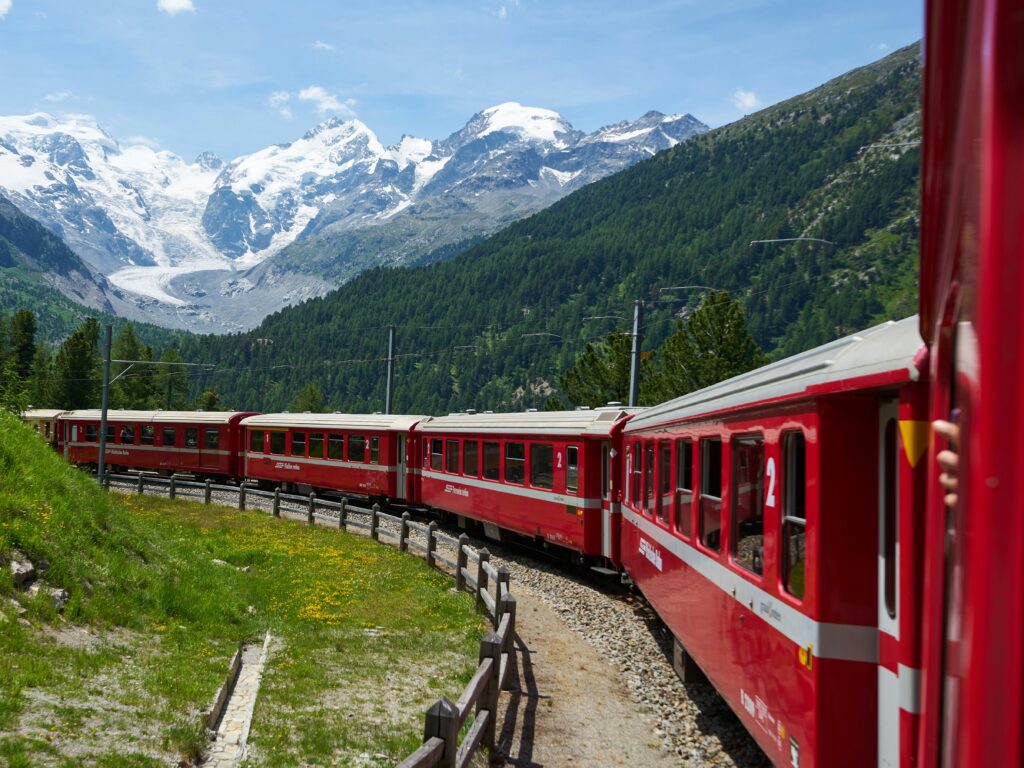Picture this: A gleaming red train winds through snow-capped peaks, past pristine lakes that mirror the sky, while you sit comfortably inside, watching one of the world’s most spectacular landscapes unfold before your eyes. Have you ever dreamt of this iconic Swiss experience?
Switzerland’s trains are legendary worldwide for three reasons: unmatched punctuality, exceptional efficiency, and breathtaking scenic routes that transform travel into the destination itself. For Indian travelers, mastering the Swiss train system isn’t just about getting from point A to point B—it’s your golden ticket to unlocking Switzerland’s true alpine magic.
This comprehensive guide is specifically crafted for Indian travelers navigating the intricacies of Swiss rail travel. We’ll demystify everything from the various types of passes and individual tickets to purchasing strategies and cost considerations. Getting your hands on the right Swiss train tickets can seem daunting at first, but this guide will transform that complexity into confidence, ensuring your Swiss adventure runs as smoothly as the trains themselves.



Why Swiss Trains are a Traveler’s Dream
Swiss train travel transcends mere transportation—it’s an integral part of your alpine adventure. Imagine settling into plush seats behind floor-to-ceiling panoramic windows, feeling the gentle rhythm of rails as you glide effortlessly through landscapes that look like postcards come to life. These aren’t just trains; they’re moving observation decks offering front-row seats to some of Earth’s most stunning scenery.
The legendary punctuality of Swiss trains is a game-changer for Indian travelers accustomed to uncertain schedules. Swiss Federal Railways operates with clockwork precision—trains arrive and depart exactly on time, allowing you to plan your itinerary with military precision and maximize every precious moment of your vacation.
The extensive network connects bustling cities to remote mountain villages with remarkable efficiency. Whether you’re traveling from cosmopolitan Zurich to the car-free streets of Zermatt or from lakeside Geneva to the Alpine paradise of Interlaken, trains reach destinations that would require winding mountain drives, eliminating the stress of navigation and parking.
Perhaps most remarkably, certain routes like the famous Glacier Express and Bernina Express aren’t just transportation—they’re world-renowned experiences in themselves. These panoramic journeys transform travel time into unforgettable memories, making the journey every bit as spectacular as the destination.
Decoding Swiss Train Tickets & Passes for Indians
Switzerland offers a sophisticated array of travel options designed to accommodate different itineraries, budgets, and travel styles. Understanding these options is crucial for making informed decisions that can significantly impact both your experience and expenses.
The Swiss Travel Pass
The Swiss Travel Pass stands as Switzerland’s premier travel solution—an all-in-one ticket providing unlimited travel across the country’s entire network of trains, buses, and boats. Think of it as your master key to Switzerland’s transportation system.
For Indian travelers, the convenience factor cannot be overstated. Instead of fumbling with individual tickets for each journey, you simply hop on and off trains at will. The Swiss Travel Pass for Indians offers exceptional value through its additional benefits: free entry to over 500 museums across the country, which alone can save hundreds of francs for culture enthusiasts.
The pass comes in two variants: consecutive passes (valid for continuous days) and flexi passes (valid for selected days within a one-month period). Choose consecutive if you’re traveling daily, or flexi if you plan rest days or longer stays in specific locations.
Point-to-Point Tickets
These straightforward A-to-B tickets work perfectly for travelers with fixed itineraries involving only a few train journeys. If you’re visiting Switzerland for a specific event or have a very focused travel plan, individual tickets might be more economical than a comprehensive pass.
However, for multiple long-distance journeys, these tickets can quickly become more expensive than a pass. The key is calculating your planned routes’ total cost before deciding.
The Swiss Half Fare Card
The Swiss Half Fare Card offers a middle ground, providing 50% discounts on most train, bus, and boat tickets throughout Switzerland. This option appeals to travelers who prefer flexibility in their journey planning while still achieving significant savings.
To determine if this suits your needs, calculate whether your total discounted ticket costs would be less than a Swiss Travel Pass price. This card works particularly well for travelers mixing long scenic routes with shorter local journeys.
Eurail Pass in Switzerland
Many Indian travelers embarking on multi-country European adventures wonder about using their Eurail Pass in Switzerland. While Eurail Passes are valid on Switzerland’s national railway network, the Swiss Travel Pass often provides superior value within Switzerland, offering additional benefits like museum entries and local transport that Eurail doesn’t include.
When comparing Eurail vs Swiss Travel Pass, consider that the Swiss-specific pass typically offers more comprehensive coverage and benefits for Switzerland-focused travel.
Regional Passes
For travelers concentrating on specific regions, specialized passes like the Berner Oberland Pass offer excellent value for area-focused exploration, though these work best when combined with broader travel passes for complete Switzerland coverage.
How to Buy Swiss Train Tickets: A Step-by-Step Guide for Indians
Online Purchase Through SBB Website
The Swiss Federal Railways (SBB) official website (sbb.ch) serves as Switzerland’s primary and most reliable ticketing platform. The process is straightforward: enter your departure and destination stations, select your travel date and time, choose your preferred ticket type, and complete payment in Swiss Francs (CHF).
Learning how to buy Swiss train tickets online through SBB ensures you get official prices and can plan your entire journey in advance. The website offers an English interface and accepts international credit cards, making the process seamless for Indian travelers.
The SBB Mobile App
Download the SBB Mobile app before your trip—it’s genuinely indispensable for Swiss train travel. Beyond ticket purchases, the app provides real-time platform information, delay notifications, and digital ticket storage. The SBB Mobile app train booking functionality mirrors the website while adding location-based features that prove invaluable when you’re on the move.
The app’s offline capabilities mean you can access your tickets and basic route information even without internet connectivity, providing peace of mind in remote mountain areas.
At Swiss Train Stations
Every Swiss station features user-friendly ticket machines with English language options, making on-the-spot purchases simple. For complex queries or personal assistance, major stations maintain ticket counters staffed with English-speaking personnel who can provide detailed route advice and recommendations.
Buying in India
For maximum convenience, consider purchasing Swiss Travel Passes and other rail products from authorized travel agents in India before departure. This allows payment in Indian Rupees and eliminates the need to handle ticket purchases immediately upon arrival. When researching where to buy Swiss train tickets in India, ensure you’re dealing with officially authorized agents to avoid complications.
The Big Question: Are Swiss Trains Expensive? A Cost Breakdown
Let’s address the elephant in the room: yes, Swiss transportation can be expensive by Indian standards, but smart planning makes it manageable and worthwhile.
Swiss train ticket prices vary significantly based on routes and travel classes. Here’s a realistic breakdown of popular routes:
Zurich to Interlaken: Approximately CHF 45-80 for second class, depending on the specific route and time. This journey, popular among Indian tourists heading to the Jungfrau region, takes about 2-3 hours and offers stunning lake and mountain views.
Geneva to Zermatt: Expect to pay around CHF 80-120 for this spectacular journey to the Matterhorn’s base, involving a scenic train change in Visp.
Scenic Train Costs
The famous panoramic routes require additional considerations beyond standard tickets:
Glacier Express: Beyond your valid travel ticket or pass, mandatory seat reservations cost approximately CHF 49. The cost of Glacier Express ticket for the complete St. Moritz to Zermatt route reaches about CHF 159 in second class if you don’t have a pass.
Bernina Express: Seat reservations cost around CHF 36 during high season, with full route tickets from Chur to Tirano priced similarly to other scenic routes.
For budget-conscious travelers, Saver Day Passes offer a money-saving alternative, providing unlimited daily travel at reduced prices when booked in advance.
Pro Tips for Saving Money: Best Time to Buy and Discounts
Timing Your Purchases
Understanding the best time to buy Swiss train tickets can yield significant savings. “Supersaver” tickets offer reduced fares for specific connections when booked in advance online or through the app, though these come with limited flexibility.
For standard point-to-point tickets, prices remain fixed regardless of purchase timing, so there’s no penalty for last-minute buying. However, passes require advance purchase and activation.
Saver Day Pass Strategy
The Saver Day Pass functions like a one-day Swiss Travel Pass, offering unlimited travel with pricing that decreases the further in advance you book. This proves particularly valuable for days involving long return journeys or multiple destinations.
Maximizing the Half Fare Card
Don’t underestimate the Half Fare Card’s potential for substantial savings, especially when combined with strategic route planning and longer stays that justify multiple journeys.
Do’s and Don’ts for Indian Travelers on Swiss Trains
Essential Do’s
Validate tickets when required: Some older ticket types need validation before boarding—look for yellow validation machines on platforms.
Keep documents ready: Ticket inspectors conduct regular checks, so have your pass and passport easily accessible.
Respect quiet zones: Many trains designate specific carriages as quiet zones where conversations should be minimal.
Use designated luggage areas: Large bags belong in overhead racks or designated luggage spaces, not on seats.
Critical Don’ts
Never put feet on seats: This violates Swiss etiquette and can result in fines.
Don’t miss your stop: While announcements are clear, stay alert as trains stop briefly at smaller stations.
Never board without valid tickets: Ticket fines are substantial and strictly enforced.
Navigating Swiss Railway Stations and Seating
Station Navigation
Swiss railway stations feature clear departure boards (blue displays) showing platform numbers, departure times, and destinations. Most major stations offer comprehensive amenities including luggage lockers, restaurants, and multilingual information desks.
Understanding this Swiss railway stations guide helps you navigate confidently from day one.
The Seating System
Here’s crucial information many guides overlook: most regular Swiss trains operate on open seating principles. You don’t need reservations and can sit in any empty seat matching your ticket class. This flexibility is particularly valuable for spontaneous travel.
Digital displays or paper reservations above seats indicate when specific seats are reserved for particular journey segments. If you see a reservation, simply find another empty seat.
Consider making reservations (costing about CHF 5) during peak holiday periods or for very long journeys if traveling in groups, but it’s rarely necessary for most travel.
Understanding how Swiss train reservations work and knowing that Swiss trains have open seating removes much anxiety from first-time travelers.
Famous Scenic Train Routes
Switzerland’s scenic trains represent some of the world’s most spectacular rail journeys, where the journey truly surpasses the destination.
Glacier Express vs Bernina Express
The Glacier Express, known as the “world’s slowest express train,” connects Zermatt and St. Moritz through high Alpine passes, taking eight hours to cover spectacular mountain terrain. The Bernina Express offers a different experience, traveling from Chur or St. Moritz to Tirano in Italy, famous for its dramatic viaducts and the unique transition from glacial landscapes to palm trees.
Both represent pinnacle train travel in Switzerland for tourists, each offering distinct perspectives on Alpine beauty.
Golden Pass Line
The Golden Pass Line Switzerland connects Lucerne with Montreux on Lake Geneva, passing through diverse landscapes of lakes, valleys, and vineyards. This route showcases Switzerland’s gentler beauty compared to the high Alpine drama of other scenic routes.
Planning Your Scenic Journey
These best Swiss scenic train routes require advance planning, particularly for seat reservations and coordination with accommodation bookings. Understanding how to travel Switzerland by train for optimal scenic experiences involves balancing multiple routes with practical travel logistics.
Frequently Asked Questions (FAQs)
Are Swiss trains expensive? It depends on your planning and travel style. While individual tickets can be costly, passes often provide excellent value, especially when you factor in included museum entries and unlimited travel flexibility.
Do Swiss trains run on time? Absolutely—Swiss punctuality is legendary. In the rare event of delays, connections are typically held, and staff provide clear information about alternative arrangements.
How do seat reservations work? Most regular trains don’t require reservations—you can sit anywhere in your ticket class. Reservations are mandatory only for specific scenic routes like the Glacier Express.
Can I eat and drink on Swiss trains? Yes, food and beverages are allowed. Many long-distance trains feature dining cars or trolley service offering regional specialties and refreshments.
Is there WiFi on Swiss trains? Most long-distance and many regional trains offer complimentary WiFi, though coverage may be limited in mountain tunnels and remote areas.
Your Swiss Rail Adventure Awaits
With this comprehensive guide in hand, navigating Switzerland’s magnificent rail system transforms from daunting to delightful. Remember that Swiss trains aren’t just transportation—they’re your gateway to experiences that will create lifelong memories.
The key takeaway for Indian travelers is that proper planning and understanding of the system make Swiss train travel not only manageable but genuinely enjoyable. Whether you’re watching the Matterhorn emerge through morning mist from a Glacier Express window or simply commuting between cities with Swiss efficiency, every journey becomes part of your Swiss story.
Share your Swiss train adventures with fellow travelers in the comments below—your experiences might inspire someone else’s perfect Swiss journey!
As you plan your Swiss adventure, remember that the most spectacular destinations are often found not at journey’s end, but in the magical moments experienced along the rails that connect them.
- Koundinya Wildlife Sanctuary Travel Guide 2026: Timings, Safari, Map, Reviews & Wildlife Highlights
- Kaas Plateau Travel Guide 2026: Best Time to Visit, Bloom Season, How to Reach & FAQs
- What Is the Quirimbas Archipelago Mozambique Known For? Complete Travel & Nature Guide
- Is Angola Safe to Travel in 2025? Your Essential Guide to Health, Crime, and Landmine Safety
- What Animals Live in Bale Mountains Ethiopia? Complete Wildlife Guide
